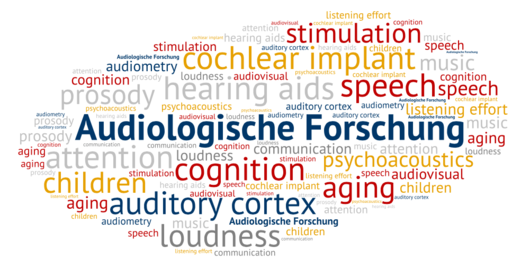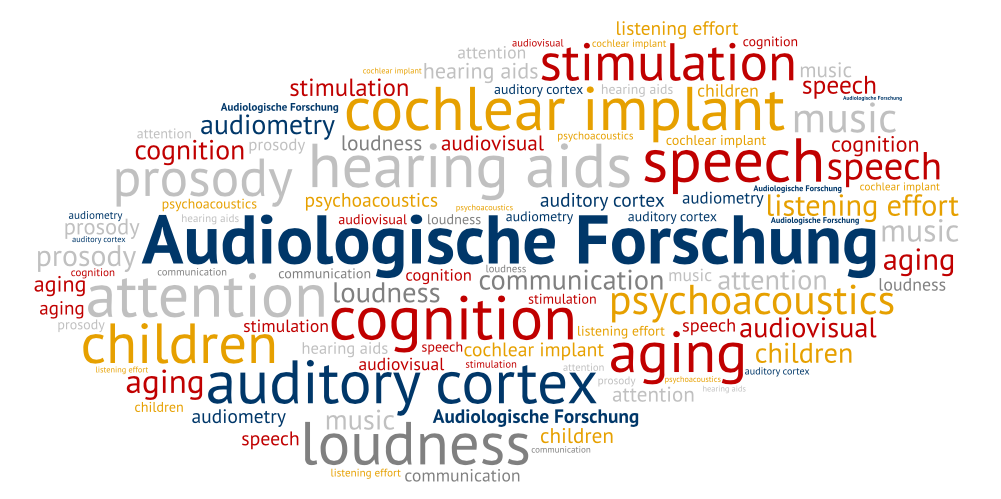
Research Topics in Audiology
The focus of our work is on the perception of speech signals, taking into account audiological, technical, linguistic and neurological aspects. Based on these findings the aim is to create clinical approaches for the improvement of diagnostics and rehabilitation of hearing disorders.
New: Moritz Wächtler wins poster prize at annual DGA-meeting
New: Khaled Abdellatif obtains Colin-Cherry-Award
New: DFG funds project on speech perception and cognitive load in cochlear implant recipients
New: DFG funds project on attention and speech recognition in the framework of aging
Read our latest publicatons:
Abdellatif KHA, Müller V, Walger M, Meister H. Music sound quality assessment in bimodal cochlera implant users. MedRxiv 2022, preprint.
Meister H, Winter IS, Wächtler M, Sandmann P, Abdellatif KHA. A virtual-reality based method for examining audiovisual prosody. ArXiv 2022, preprint.
Wächtler M, Kessler J, Walger M, Meister H. Revealing Perceptional and Cognitive Mechanisms in Static and Dynamic Cocktail Party Listening by Means of Error Analyses. Trends in Hearing. 2022;26:1-11.
The cochlear implant (CI) – an auditory neuroprosthesis- allows electrical stimulation of the auditory nerve. By means of a speech processor the sound signals are converted into electrical signals and transmitted transcutaneously to the implant. A CI is typically indicated for severe to profound hearing loss.
Due to the limited transmission of natural acoustic features, the verbal communication of persons provided with cochlear implants is subject to certain restrictions. However, cochlear implantation often results in reasonable speech intelligibility and may even allow for communication using the telephone. Crucially, this is due to an adequate neuronal processing in the auditory cortex, which allows perception and use of speech features despite the reduced input signal.
Our work relates to several aspects of speech perception with CIs. For instance, it focuses on the perception of suprasegmental features of speech that have a distinct function for verbal communication. These include prosody, namely word and sentence accent (stress patterns) or intonation patterns (e.g., questions vs. statements). Adequate processing of prosodic features is particularly important, for example, in language acquisition in early childhood.
We also focus on speech recognition with competing talkers. These are especially demanding communication situations since information from different sound sources has to be processed. We are particularly interested in the questions of whether CI recipients are able to segregate different talkers based on voice cues (such as fundamental frequency) or the spatial distribution of the sound sources. The research projects are typically conducted in cooperation with industry partners in order to directly address clinically relevant issues.
Selected publications:
Meister H, Walger M, Lang-Roth R, Müller V. Voice fundamental frequency differences and speech recognition with noise and speech maskers in cochlear implant recipients. J Acoustic Society America. 2020 Jan;147(1):EL19. doi: 10.1121/10.0000499. PMID: 32007021
Pyschny V, Landwehr M, Hahn M, Lang-Roth R, Walger M, Meister H. Head shadow, squelch, and summation effects with an energetic or informational masker in bilateral and bimodal CI users. J Speech Lang Hear Res. 2014, Oct;57(5):1942-60.
Landwehr M, Fürstenberg D, Walger M, von Wedel H, Meister H. Effects of various electrode configurations on music perception, intonation and speaker gender identification. Cochlear Implants Int. 2014 Jan;15(1):27-35.
Meister H, Landwehr M, Pyschny V, Grugel L, Walger M. Use of intonation contours for speech recognition in noise by cochlear implant recipients. J Acoust Soc Am. 2011 May;129(5):EL204-9.Meister H, Landwehr M, Pyschny V, Walger M, von Wedel H. The perception of prosody and speaker gender in normal-hearing listeners and cochlear implant recipients. Int J Audiol. 2009 Jan;48(1):38-48.
Cognitive load during speech recognition
In acoustically challenging communication situations, not only hearing ability, but also cognitive functions such as attention or working memory are of importance. Various studies have shown relationships between cognitive capacity and speech recognition. Older adults frequently do not only suffer from hearing impairment, but cognitive performance is also subject to decline. This causes extra problems for older people to communicate in demanding situations – for instance, when several persons speak simultaneously.
Our research in this area attempts to identify cognitive functions that are important for different communication situations. This includes, for example, the investigation of different forms of attention using speech audiometric as well as neuro-physiological methods (EEG, Pupillometry, Eye-Tracking). We are also interested in how technical rehabilitation of hearing (hearing aids and cochlear implants) interacts with the cognitive capacity of users.
Selected publications:
Meister H, Schreitmüller S, Ortmann M, Rählmann S, Walger M. Effects of Hearing Loss and Cognitive Load on Speech Recognition with Competing Talkers. Front Psychol. 2016 Mar 4;7:301. doi: 10.3389/fpsyg.2016.00301.
Carroll R, Meis M, Schulte M, Vormann M, Kießling J, Meister H. Development of a German reading span test with dual task design for application in cognitive hearing research. Int J Audiol. 2015 Feb; 54(2):136-41. doi:10.3109/14992027.2014.952458.
Meister H, Schreitmüller S, Grugel L, Beutner D, Walger M, Meister I.
Examining speech perception in noise and cognitive functions in the elderly. Am J Audiol. 2013 Dec;22(2):310-2
Meister H, Schreitmüller S, Grugel L, Ortmann M, Beutner D, Walger M, Meister IG. Cognitive resources related to speech recognition with a competing talker in young and older listeners. Neuroscience. 2013 Mar 1;232:74-82.
Assessment of cognitive load and listening effort
Listening effort can be defined as the expenditure necessary to understand speech. Even if speech intelligibility is near perfect, under adverse acoustic situations, it may be difficult to follow a conversation. The idea is that increased cognitive resources for otherwise largely automated and effortless speech perception are then needed.
In principle, this gives the potential to further measures, for example, to the purpose of the evaluation of hearing aid or cochlear implant provision. However, a generally useful measure of listening effort has not yet been established.
Our investigations focus on various subjective and objective measures: we examine simple rating scales, but also more complex dual task methods or neuro-physiological measures, such as pupillometry or electrodermal activity in terms of its potential to determine listening effort. Moreover, we assess the use of event-related potentials in the framework of EEG-recordings.
Selected publications:
Abdellatif K, Schreitmüller S, Walger M, Meister H. Listening effort and cognitive functions in cochlear implant users. 22. DGA-Jahrestagung 2019, Heidelberg, Z. Audiol. Suppl.
Ortmann M, Rählmann S,Walger M, Meister H: EDA (Hautleitwert) als Maß für Höranstrengung? DGMP-Jahrestagung Köln, 18.9.-21.9.2013
Igelmund P, Meister H, Brockhaus-Dumke A, Fürstenberg D, von Wedel H, Walger M (2009) P300 and reaction time as measures of hearing effort of CI users during sound discrimination in noise DGA Jahrestagung 2009, Innsbruck, Z. Audiol.
Speech information is not only perceived via the auditory system, but also visually. Especially in noisy environments there is often the need to use additional visual speech information. In particular persons with hearing impairment require visual speech information in order to compensate for a lack of auditory features. This is based on the ability to integrate different modalities at the cortical level.
We focus on the questions for which audiological testing it might be useful to include visual speech information and how audiovisual speech perception might be measured reliably within a clinical setting. Our hypothesis is that, in particular for combining acoustic and electric hearing (as with bimodal or hybrid fitting), the benefit of adding spectro-temporal fine structure might be better represented through audiovisual speech tests compared to conventional speech audiometry. This holds at least as long as the different cues (envelope information, fine structure, visual speech) provide complementary information. Here, we use the opportunities of virtual reality enabling to visualize arbitrary speech material via computer-animated avatars. This gives the option to parametrize visual and auditory cues important for multi-modal speech perception.
Other important aspects we are interested in are cross-modal cortical plasticity with cochlear implantation and the high ecological validity of audiovisual compared to auditory-only speech.
Selected publications:
Schreitmüller S, Frenken M, Bentz L, Ortmann M, Walger M, Meister H. Validating a Method to Assess Lipreading, Audiovisual Gain, and Integration During Speech Reception With Cochlear-Implanted and Normal-Hearing Subjects Using a Talking Head. Ear Hear. 2017 Oct 24. doi:10.1097/AUD.0000000000000502. [Epub ahead of print]
Meister H, Fürsen K, Schreitmüller S, Walger M. Effect of acoustic fine structure cues on the recognition of auditory-only and audiovisual speech. J Acoust Soc Am. 2016 Jun;139(6):3116. doi: 10.1121/1.4953022.
Meister H, Schreitmüller S, Pyschny V, Lang-Roth R, Walger M, Fagel S (2011) Untersuchungen audio-visuellen Sprachwahrnehmung Personen mit Hörstörungen mittels virtuellem Kopfmodell. DGA Jahrestagung 2011, Jena, Z. Audiol. Suppl
In Germany, about 14 million people suffer from hearing problems. Especially older persons frequently exhibit hearing loss and communication problems as a consequence. Despite the large progress in hearing technology within the last decade, hearing aid provision is quantitatively insufficient, since many who might benefit from hearing instruments do not use these.
The focus of our research is the identification of key factors relevant to hearing aid provision. We aim at determining mechanisms that either support or hamper hearing aid uptake as well as at describing models that allow for a prediction of hearing aid use. It is assumed that a deeper understanding of the effects relevant to hearing aid usage will help to improve hearing aid provision and rehabilitation services in general.
With respect to the latter, not only technological issues, but also educational aspects, are relevant. For example, counselling and auditory training might help to support hearing aid use. Another approach is cognitive training, since we know that cognitive capacity, speech understanding and hearing technology are linked a specific training of working memory or attention might be beneficial.
Selected publications:
Meister H, Grugel L, Meis M. Intention to use hearing aids: a survey based on
the theory of planned behavior. Patient Prefer Adherence. 2014 Sep 17;8:1265-75.
Ortmann M, Kessler J, Kaul T, Arehart KH, Meister H. Cognitive training to improve
speech understanding in complex communication environments
- a framework and methodological aspects. HEAL Conference 6/2014
Meister H, Grugel L, Walger M, von Wedel H, Meis M. Utility and importance of
hearing-aid features assessed by hearing-aid acousticians. Trends Amplif. 2010
Sep;14(3):155-63.
Meister H, Walger M, Brehmer D, von Wedel UC, von Wedel H. The relationship
between pre-fitting expectations and willingness to use hearing aids. Int J
Audiol. 2008 Apr;47(4):153-9.
Meister H, von Wedel H. Demands on hearing aid features--special signal
processing for elderly users? Int J Audiol. 2003 Jul;42 Suppl 2:2S58-62.
Meister H, Lausberg I, Kiessling J, von Wedel H, Walger M. Modeling
relationships between various domains of hearing aid provision. Audiol Neurootol.2003 May-Jun;8(3):153-65.
The acquisition of language by children is the basis for an adequate emotional, social and intellectual development. It is subject to a variety of factors. Important aspects are hearing and speech processing in critical stages of language acquisition. Speech production is closely related to speech perception and processing.
Our research interests focus on children who exhibit hearing loss in sensitive stages of development. This may relate to auditory processing disorders as well as impairment of the middle ear, the inner ear or the auditory nerve.
A current research project is the examination of language and hearing development in children provided with hearing devices (especially cochlear implants, CI), including children with multiple disabilities. This research is based on a recently developed parents proxy questionnaire and supplemented with further testing. The FAPCI ("Functioning after Pediatric Cochlear Implantation"), which has been validated and translated to a German version (Grugel et al. 2009, 2011), is used as a main inventory.
With respect to real-world verbal communication (initially without distinction of language and auditory development), the score of FAPCI seems to be sensitive to the point in time at which intervention takes place. Further studies should be included to test the hypothesis of early rehabilitation with respect to sensitive phases of language acquisition.
Selected publications:
Meister H, Keilmann A, Leonhard K, Streicher B,Lang-Roth R. Real-world verbal communication performance of children provided with cochlear implants or hearing aids. Otol Neurotol. 2015 Jul;36(6):1023-8.Grugel L, Streicher B, Lang-Roth R, Walger M, Meister H. Measuring communicative performance with the German version of the FAPCI-instrument: normative data and longitudinal results. Int J Pediatr Otorhinolaryngol. 2011 Apr;75(4):543-8.




